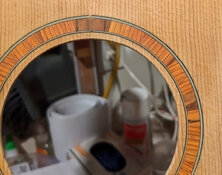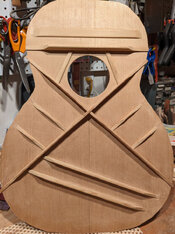Thanks for the feedback and positive comments and support Arn. I've really enjoyed building and learning about guitars. I don't know how many, if any, more I'll make. I have four of them stacked in my bedroom now. But it was always a sort of reassuring feeling when I have one in progress - sort of like having something to look forward to.
Regarding #4 here - yes, the headstock will be slotted and will have a cocobolo headplate. I'm hoping we'll be able to inlay my flying fish logo but there may not be enough room. Plus we no longer have access to a CNC. But that'd be okay if the fish isn't on there. The binding will be cocobolo - in fact I have the strips and the bender here at home and will bend them after I get back from fishing and right before my coach and I get together to do the binding. He has a full selection of bearings for the router so it's easier to go to his shop and set up the router. Plus, based on the first three guitars, binding is way easier with two people. The neck itself will be mahogany and yes, it'll have a stabilizing/strengthening volute (bird's beak in Martin terminology) at the transition to headstock. The only thing we probably won't do is bind the fretboard because the fretboard is cocobolo. All the cocobolo bits are cut from the same board my dad brought back from Panama.
Yes, I know how special that Panama rosewood is as it came from your Dad. It’s a great way to use it and pay tribute to him- maybe think of something to inject in the guitar that is memorable of who and what your Dad is to you.
Trust me a little on binding the fretboard- not trying to influence you, but I am looking at the whole picture of what would elevate this build to that next level of consistency and appropriateness with the colors and details that you have going on. Try to visualize how you have the yellow (fretboard & bridge), the brown on the back and sides, the orange with brown on the rosette. You have an analogous color scheme. Working with “color or color”. Stay with me a bit and I’ll walk you through. If you lay out those colors out- cut a little sample and spread them out. What I want you to look at is the combination or probability of using those 3 or 2 colors for the binding. Let’s take the fretboard and isolate it. You have yellow as the dominant color. We have to consider the back and sides and how the binding combination would work with that as well.
Let’s have a 3 piece lamination binding scenario of orange/yellow/brown and back to the yellow of the fretboard. You can simply that further and use a 2 piece binding lamination of orange/brown binding back to the yellow fretboard.
Let’s deal with the back and side binding that will also affect the yellowish tan soundboard. You can use the 3 or 2 binding approach option I gave you and see how it works as a whole. My take on that is that you consolidate to a 2 ply binding of orange/brown- the orange on the outside and the brown in the inside.
Headstock overlay- you can go multiple ways. You can use the yellow as the headstock overlay and then go back to the brown to orange binding combo. That would create color relationship with everything you have. Now you can go for that darker frame on the headstock- use whatever drop off you have from your dad’s Panamanian rosewood. That pulls the color from the back and the little accent from the rosette to “continue” the dialogue. If you now take the binding scheme of brown (outside)/orange (inside) back to the brown headstock overlay.
I know this is a lot of information and what helps me visualize this is from being on the interior design side, being able to apply color theory and be able to work out the color combination so you have consistency and continuum.





















